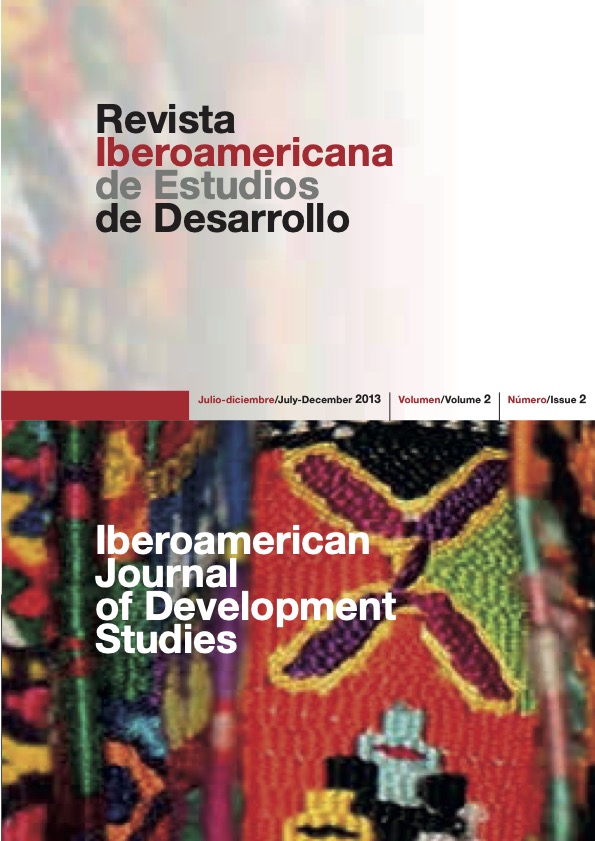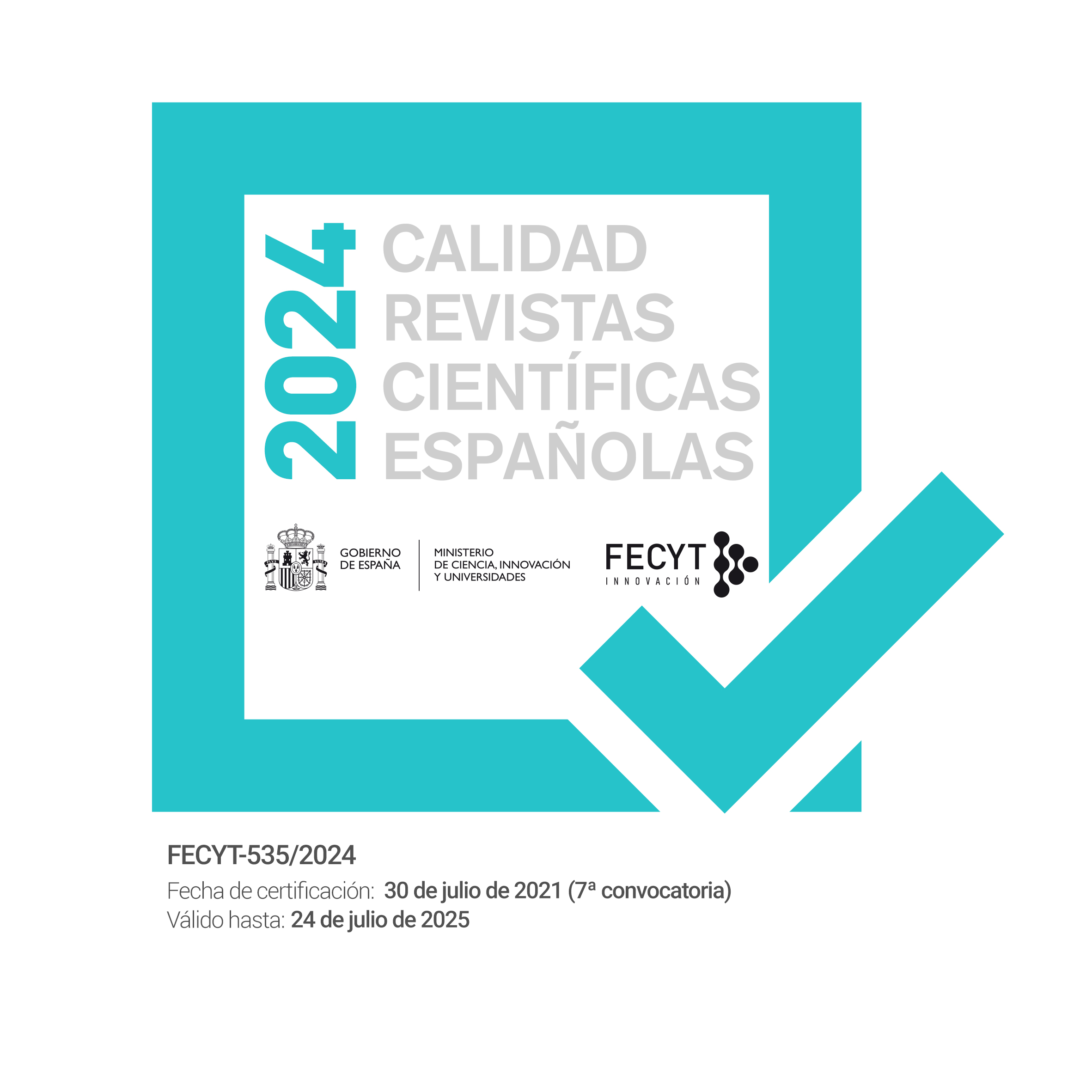Is Product Diversification the Ultimate Quid Pro Quo for Gender sensitive Poverty Alleviation? Adverse Social Externalities from Combined Microfinance in Latin America and the Caribbean
DOI:
https://doi.org/10.26754/ojs_ried/ijds.60Palabras clave:
microseguros, microcréditos, microahorros, pobreza, inclusión social, géneroResumen
Las deficiencias probadas de los mecanismos tradicionales de transferencia social han provocado la aparición de métodos alternativos para reducir la pobreza. En muchos países, las instituciones de microfinanzas (IMFs) se han convertido en instrumentos habituales de las políticas redistributivas a favor de los pobres. Sin embargo, han sido criticadas por no ser suficientemente inclusivas. Este artículo analiza si la diversificación de producto tiene un efecto sobre el alcance de la pobreza, en particular, cuando se combinan microcréditos con ahorros y seguros. El artículo aplica un análisis transversal a 250 programas de microfinanzas en Latinoamérica y el Caribe. Al centrarse en elementos de la profundidad del alcance de la pobreza, la investigación pone de relieve varios efectos posibles de las microfinanzas combinadas. La diversificación de producto puede contribuir significativamente a incrementar el alcance social (amplitud del alcance de la pobreza). Sin embargo, los resultados sugieren que, en el caso de créditos combinados con ahorros, llevan a una participación relativamente más baja de los clientes pobres y mujeres (profundidad del alcance de la pobreza). Vulnerabilidades y dinámicas excluyentes y discriminatorias, unidas a productos financieros específicos, podrían aplicarse doblemente o incluso reforzarse mutuamente. Las barreras de comunicación, geográficas, culturales o financieras pueden hacer que la participación en múltiples productos financieros sea más difícil. Los resultados no han sido adecuadamente abordados por la literatura académica, pero son especialmente relevantes para inversores en microfinanzas y legisladores. Si la generación de ingresos sensibles al género o a la pobreza está en el centro de la misión de las IMFs, deberían ser consideradas medidas correctoras de estos factores externos adversos.
Descargas
Referencias
ADJEI J, ARUN T, HOSSAIN F (2009). Asset Building and Poverty Reduction in Ghana: the Case of Microfinance. Savings and Development, pp 265-291
AGIER I, GUÉRIN I, SZAFARZ A (2011). Child Gender and Parental Borrowing: Evidence from India. Available at SSRN: http://ssrn.com/abstract=1792872
AHUJA R, JÜTTING J (2004). Are the Poor Too Poor to Demand Health Insurance? Journal of Microfinance 6 (1):1-20
AMIN S, RAI AS, TOPA G (2003). Does microcredit reach the poor and vulnerable? Evidence from northern Bangladesh. Journal of Development Economics 70I(1):9-82
ARMENDÁRIZ B, MORDUCH J (2005). The economics of Microfinance. MIT Press
ARMENDÁRIZ B, SZAFARZ A (2009). On Mission Drift in Microfinance Institutions. CEB Working 09/015(29)
ARMENDÁRIZ B, VANROOSE A (2009). Uncovering Microfinance Myths: Does Country- Wide Age Matter? Reflets et Perspectives de la vie économique. La microfinance sous la direction de Marc Labie xlvii (3):7-17
ASHRAF N, KARLAN D, YIN W (2010). Female Empowerment: Impact of a Commitment Savings Product in the Philippines. World Development, 38(3):333-344
BANERJEE A, DUFLO E, GLENNERSTER R, KINNAN C (2009). The miracle of microfinance? Evidence from a randomized evaluation, Abdul Latif Jameel Poverty Action Lab at MIT and the Center for Microfinance at IFMR. 40 pp; available at: http://www.povertyactionlab.com/papers/101_Duflo_Microfinance_Miracle.pdf
BARR S, KUMAR A, LITAN RE (2007). Building Inclusive Financial Systems. A Framework for Financial Access. Brookings Institution Press, 198 pp
BASADA R, CRIEL B, VAN DER STUYFT P (2008). Community health insurance in Uganda: Why does enrolment remain low? A view from beneath. Health Policy 87(2):172-184
BHATTAMISHRA R, BARRETT CB (2010). Community-Based Risk Management Arrangements: A Review. World Development 38(7):923-93
BOYE S, HAJDENBERG J, POURSAT C (2006). Le guide de la microfinance. Microcrédit et épargne pour le développement. Editions d’Organization
BRUETT TA (2006). Measuring Performance of Microfinance Institutions: A Framework for Reporting, Analysis, and Monitoring. SEEP Network and Alternative Credit Technologies, LLC
CGAP (2003). Microfinance Consensus Guidelines. Definitions of Selected Financial Terms, Ratios, and Adjustments for Microfinance. CGAP and The World Bank Group
CHURCHILL C (2000). Trying to Understand the Demand for Microinsurance. Journal of International Development 14:381-387
CHURCHILL C (2006). Protecting the Poor. A Microinsurance Compendium. ILO, CGAP and Munich Re Foundation
CHURCHILL C, FRANKIEWICZ C (2006). Making microfinance work: managing for improved performance. ILO
COLLINS D, MORDUCH J, RUTHERFORD S, RUTHVEN O (2009). Portfolios of the Poor: How the World’s Poor Live on $2 a Day. Princeton University Press
COPESTAKE J (2007). Mainstreaming Microfinance: Social Performance Management or Mission Drift? Elsevier, World Development 35(10):1721-1738
CULL R, DEMIRGÜÇ-KUNT A, MORDUCH J (2008). Financial Performance Meets the Market. World Bank Policy Research Working Paper 4630:38
DALEY-HARRIS S (2007). Microcredit Summit Campaign Report
DEKKER M, WILMS A (2010). Health Insurance and Other Risk-Coping Strategies in Uganda: The Case of Microcare Insurance Ltd. World Development 38(3):369-378
DEWAN I, SOMANATHAN R (2007). Poverty targeting in public programs: A comparison of some nonparametric tests and their application to Indian microfinance. Centre for Development Economics, Department of Economics, Delhi School of Economics 154:18
DROR D, RADERMACHER R, KOREN R (2007). Willingness to pay for health insurance among rural and poor persons: Field evidence from seven micro health insurance units in India. Health Policy 82(1):12-27
DUPAS P, ROBINSON J (2009). Savings Constraints and Microenterprise Development: Evidence from a Field Experiment in Kenya. NBER Working Papers 14693, National Bureau of Economic Research
FERNANDO JL (2006). Microfinance. Perils and Prospects. Routledge Studies in Development Economics, Routledge
FLETSCHNER D (2009). Rural Women’s Access to Credit: Market Imperfections and Intrahousehold Dynamics. World Development 37(3): 618-631
GINE X (2007). Why Does Access Matter? Impact on Growth and Poverty, in Building Inclusive Financial Systems. A Framework for Financial Access. Brookings Institution Press
GINE X, YANG D (2009). Insurance, credit, and technology adoption: Field experimental evidence from Malawi. Journal of Development Economics 89 (1):1-11
GOLDMARK L (2001). Microenterprise development in Latin America: Towards a new flexibility. Journal of Socio-Economics 30 (2):145-149
GUÉRIN I, PALIER J, PREVOST B (2009). Femmes et Microfinance. Espoirs et désillusions de l’expérience indienne. Editions des archives contemporaines et l’Agence de la francophonie (AUF)
HAMELIN A (2007). Les limites de l’utilisation du micro crédit dans la lutte contre la pauvreté: le cas du travail des enfants. Université Robert Schuman de Strasbourg, Presentation CERMi 18 december
HELMS B (2006). Access for all: building inclusive financial systems. CGAP, The World Bank
HUDON M (2007). Social Justice with Credits to the Poor: A Neo-Contractarian Approach. CEB Working Paper 07/003, Solvay Business School, Université Libre de Bruxelles (ULB) and Harvard University
INDIRA M (2005). Social Externalities of women’s empowerment through microfinance: a comparative study of two interventions, in Microfinance Challenges: Empowerment or Disempowerment of the poor? Institut Français de Pondichéry, pp 303-324; 345- 373
ILO (2009). Small change, Big changes: Women and Microfinance. Bureau for Gender equality and Social Finance Programme
JÜTTING J (2004). Do Community-based Health Insurance Schemes Improve Poor People’s Access to Health Care? Evidence From Rural Senegal, World Development 32(2):273-288
LABIE M (2009). Microfinance: évolutions du secteur, diversification des produits et gouvernance. Reflets et Perspectives de la vie économique xlvii(3):5-6
LABIE M, NGONGANG I, NYSSENS M, WÉLÉ P (2006). Analyser l’articulation entre micro-finance et micro-assurance santé: Réflexions à partir de trois cas béninois. Working paper, Documents d’économie et de gestion, Centre de Recherche Warocqué, Mons
LAPENU C, ZELLER M, GREELEY M, CHAO-BEROFF R, VERHAGEN K (2004). Performances sociales: Une raison d’être des institutions de microfinance et pourtant encore peu mesurées. Quelques pistes, Mondes en Développement 32:51-68
LASHLEY J (2004). Microfinance and Poverty Alleviation in the Caribbean. A Strategic Overview. Journal of Microfinance, 83-94
LEE JJ, SAWADA Y (2010). Precautionary saving under liquidity constraints: Evidence from rural Pakistan. Journal of Development Economics 91(1):77-86
MCINTOSH C, WYDICK B (2005). Competition and microfinance. Journal of Development Economics 78 (2):271-298
MAHJABEEN R (2008). Microfinancing in Bangladesh: Impact on households, consumption and welfare. Journal of Policy Modelling 30(6):1083-1092
MALDONADO J H, GONZÁLEZ-VEGA C (2008). Impact of Microfinance on Schooling: Evidence from Poor Rural Households in Bolivia. World Development 36(11):2440-2455
MATIN I (2005). The very poor who participate in microfinance institutions and those who never have. Small Enterprise Development 16 (3):51-57
MORRIS G, BARNES C (2005). An Assessment of the Impact of Microfinance. A Case Study from Uganda. Journal of Microfinance 7(1):39-53
MORDUCH J (1999). The Microfinance Promise. Journal of Economic Literature xxxvii:1569-1614
NADER YF (2008). Microcredit and the socio-economic wellbeing of women and their families in Cairo. Journal of Socio-Economics 37(2):644-656
OLIVARES-POLANCO F (2005). Commercializing microfinance and deepening outreach: Empirical evidence from Latin America. Journal of Microfinance 7:47-69
PATT A, SUAREZ P, HESS U (2010). How do small-holder farmers understand insurance, and how much do they want it? Evidence from Africa. Global Environmental Change 20(1)153-161
PAES DE BARROS R, FERREIRA FHG, MOLINAS VEGA JR, CHANDUVI JS (2009). Measuring Inequality of Opportunities in Latin America and the Caribbean. A copublication of Palgrave MacMillan and the Worldbank
POURSAT C (2004). Micro-assurance santé et microfinance: quelques enseignements du programme pilote du GRET au Cambodge. Rapport 2003 du Centre Walras, Economica, Paris, pp 56-66
RAHMAN A (2004). Microcredit and Poverty Reduction: Trade-Off between Building Institutions and Reaching the Poor, in Livelihood and Microfinance: Anthropological and Sociological Perspectives on Savings and Debt. Eburon Publishers, pp 27-42
RUTHERFORD S (2005). Why Do the Poor Need Savings Services? What They Get What They Might Like, in Savings Services for the Poo. Kumarian Press, Bloomfield, 378 pp
ROBINSON M (2004). Mobilizing Savings from the Public: Basic Principles and Practices. SPEED-USAID, Women’s World Banking, 51 pp
ROSSEL-CAMBIER K (2010). Combined Micro-Finance: A Conceptual Approach revealing Relevant Knowledge Gaps. Savings and Development 1(xxxiv):73-95
ROSSEL-CAMBIER K (2011). Microfinance Product Diversification: A Domino Effect of Opportunities or Vulnerabilities? A Case Study in Barbados. Asian Journal of Latin American Studies 24(3): 1-27
ROSSEL-CAMBIER K (2012). Can Combined Microfinance Boost Economic Results? An Empirical Cross-sectional Analysis. Review of Economics and Finance 2(3):79-94
SCHREINER M (2002). Aspects of Outreach: A Framework for the Discussion of the Social Benefits of Microfinance. Journal of International Development 14:591-603
SEN A (2000). Development as Freedom. Anchor Books, New York
SERVET JM (2005). Le besoin d’objectifs principaux nouveaux pour la microfinance: lutter contre les inégalités et faire face aux risques. Techniques Financières and Développement, Epargne Sans Frontières
SIMANOWITZ A, PAWLAK K (2005). Social Performance Management in Microfinance: Guidelines, Imp-Act. Institute of Development Studies
SINHA T, RANSON MK, MILLS A. (2007). Protecting the Poor? The Distributional Impact of a Bundled Insurance Scheme. World Development 35(8):1404-1421
STEPHENS B (2009). Before the Crisis: A look at MFI trends in 2005-2007, Bulletin Highlights, The MicroBanking Bulletin. Microfinance Information Exchange 18:20-26
WOLLER G (2005). Building Successful Microfinance Institutions by Assessing Clients’Needs. The Seep Network, Washington D.C
WORLD BANK INSTITUTE (2005). Introduction to poverty analysis. 218 pp. Available online in September 2009 at: http://siteresources.worlBANK.org/PGLP/Resources/PovertyManual.pdf
Descargas
Publicado
Número
Sección
Licencia
Derechos de autor 2013 Koen Rossel-Cambier

Esta obra está bajo una licencia internacional Creative Commons Atribución-NoComercial-SinDerivadas 4.0.






